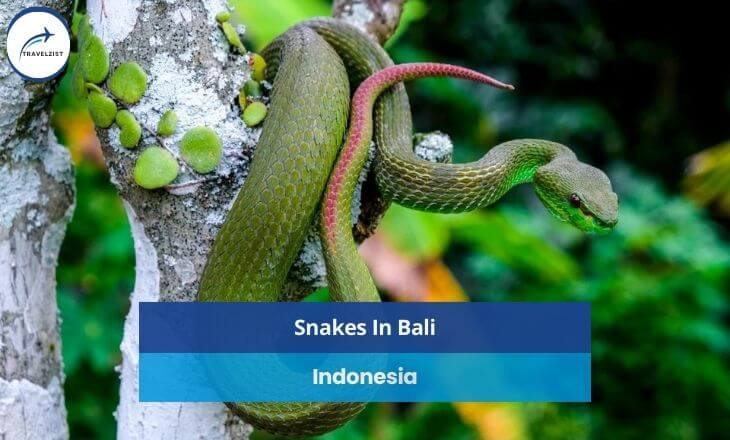Nestled among the lush jungles and pristine beaches of Bali lies a hidden danger that lurks beneath the surface – deadly and venomous snakes. These enigmatic Snakes in bali, revered in Balinese culture yet feared for their potent venom, play a crucial role in the island’s delicate ecosystem.
In this article, we will embark on a thrilling journey to uncover six of the most lethal serpents that call Bali home, shedding light on their mesmerizing beauty and formidable lethality.
Where To Stay In Bali
When you visit Bali, you can stay in popular areas. If you want lots of nightlife and entertainment, choose Kuta, Seminyak, or Canggu in the south. These areas have budget hostels and luxury resorts, and are close to beaches, restaurants, and shops.
If you like peaceful places, you might enjoy Ubud in central Bali. It’s known for its beautiful rice fields, art galleries, and yoga studios. You can stay in boutique snakes in Bali hotel or eco-friendly villas in the countryside for a traditional Balinese experience. The best place to stay in Bali depends on what you like to do, the atmosphere you prefer, and how much you want to spend.
How To Avoid Bali Snakes
To avoid snakes, pay attention and take precautions when exploring. Stick to clear paths and avoid dense vegetation or tall grass where snakes may hide. Wear sturdy, closed-toe shoes and long pants for protection against snake bites.
It’s important to learn about the serpents in Bali and where they live. This can help you avoid areas where snakes are likely to be. Also, knowing how to treat a snakebite and getting medical help right away if bitten can reduce the risks of encountering snakes.
6 Dangerous / Venomous Snakes Of Bali
Bali, known for its stunning beaches and rich cultural heritage, is also home to some of the most dangerous venomous snakes in the world.The List of the venomous snakes is given below:
Island Pit Viper (Trimeresurus Insularis)
The Pit Viper, also known as the Trimeresurus Insularis, is a highly venomous snake found in the dense forests and jungles of Bali Island. Their striking green and yellow scales make them a sight to behold, but their potent hemotoxic venom makes them one of the most dangerous snakes on the island. Often hiding in the undergrowth and low-lying vegetation, encounters with the Pit Viper can be deadly if not approached with caution.
Their potent neurotoxic venom attacks the central nervous system, causing paralysis and organ failure in its victims.

King Cobra (Ophiophagus Hannah)
Another formidable serpent that calls Bali home, we have the infamous King Cobra (Ophiophagus Hannah). Known for its distinctive hood and intimidating size, this species of snake strikes fear into those who encounter it. With a potent mixture of neurotoxic and cytotoxic venom, a bite from this majestic yet deadly reptile can bring swift paralysis followed by necrosis at the site of injection. Despite their fearsome reputation, these creatures play a vital role in maintaining ecological balance within Bali’s diverse ecosystem.
Javan Spitting Cobra (Naja Sputatrix)
The Javan Spitting Cobra, also known as Naja Sputatrix, is one of the most dangerous venomous snakes found in Bali. Its ability to spit venom accurately up to 6 feet makes it a formidable threat, especially when encountered in close proximity. The neurotoxic venom of this snake can cause paralysis and even death if not treated promptly, making it a top concern for both locals and visitors alike.

Malayan Krait (Bungarus Candidus)
Another lethal serpent that lurks in the shadows of Bali is the Malayan Krait (Bungarus Candidus). Despite its relatively small size, this snake packs a potent punch with its highly toxic venom. Often spotted near human settlements or hiding in debris, the Malayan Krait poses a significant risk due to its nocturnal habits and cryptic nature. With their sleek bodies and stealthy movements, these snakes serve as a reminder of the peril that can be found within Bali’s natural landscape.
Banded Sea Krait (Laticauda Colubrina)
The Banded Sea Krait, also known as Laticauda colubrina, is among the six venomous snakes found in Bali. Despite its potentially lethal venom, this striking sea snake can often be spotted swimming near the island’s shores. Its distinctive bands of black and white make it a visually captivating yet dangerous creature to encounter. What sets this snake apart is its ability to hunt both on land and in water, making it a formidable predator that demands respect from anyone crossing its path.

Reticulated Python (Malayopython Reticulatus)
Next on our list is the Reticulated Python, scientifically known as Malayopython reticulatus. This colossal serpent is not only one of the world’s longest snakes but also one of Bali’s most perilous reptiles due to its deadly constriction method.
With a patterned skin resembling an intricate network, the reticulated python mesmerizes and intimidates simultaneously. Encounters with this powerful apex predator serve as sobering reminders of nature’s raw power that commands awe mixed with caution when treading through Bali’s diverse landscapes.
Are There Snakes In Bali Rice Fields?
Yes, there are snakes on Bali rice fields. Bali is home to a variety of snake species, including the Javan spitting cobra and the banded krait, which are commonly found in rice fields and other agricultural areas. While encounters with snakes in rice fields are not uncommon, they typically do not pose a significant threat to farmers or visitors as long as precautions are taken.
Are There Snakes On Bali Resorts?
Yes, there are snakes On Bali resorts. Bali is home to a variety of snake species, including the highly venomous king cobra and the green pit viper. While snake encounters are not common in resorts, it’s important to be aware of your surroundings and take precautions when exploring outdoor areas.
To minimize the risk of encountering snakes, it’s advisable to stay on designated paths and avoid walking through tall grass or dense vegetation. Keeping accommodation doors closed and being mindful of any potential snake habitats can help reduce the likelihood of an unexpected encounter. Overall, while snakes do exist in Bali resorts, taking simple precautions can help ensure a safe and enjoyable stay.
Who Can Help With Bali Snakes?
If you see snakes and need help, you have a few options. You can contact local wildlife rescue or conservation groups in Bali. They have trained professionals who can safely capture and move snakes without hurting them. You can also contact a professional snake removal service in Bali.
They can safely remove different types of snakes from your property. If you’re at a hotel or resort in Bali, tell the staff about the snake sighting. They likely have procedures for dealing with such situations. Most snakes are not venomous, but it’s still important to be careful and get professional help when dealing with them.
Bali Snake Bites: What To Do If You’re Bit
Bali has beautiful landscapes and a rich culture, but it’s also home to venomous snakes. If you get bitten by a snake in Bali, stay calm and seek medical help right away. Don’t try to treat the bite yourself. While waiting for help, try to keep the affected area still and lower than your heart. Don’t use ice or tourniquets, as they can make the damage worse.
After getting medical treatment for a snake bite in Bali, it’s important to follow the aftercare instructions from the healthcare professionals. This usually means keeping the wound clean and watching for signs of infection. Depending on the snake that bit you, you may get anti-venom. It’s scary to get bitten by a snake, but staying calm and getting medical help right away is crucial for the best outcome.

Snake Bites & Deaths In Bali
In 1999, an Australian surfer named Peter Crawford died from a snake bite in Bali. The type of snake that bit him is still unknown. In 2013, a security guard at the Hyatt hotel in Sanur, Indonesia, was killed by a 15-foot python while trying to move it off the road at night. The snake wrapped around his neck and strangled him.
In 2016, a member of the Bali Reptile Rescue company died at Jembrana hospital in West Bali after being bitten by a king cobra. I Putu Agus Edi Darmawan was relocating a mother cobra and eggs when he was bitten on the finger. He had been doing snake rescues for 15 years at the time of his death and was a valued member of the Bali snake community.
In 2017, a woman from Australia got bitten by a brown snake in Ubud. She got very sick quickly, started throwing up and passing out, but she got anti-venom at a hospital in Ubud and lived. In 2019, a 12-year-old girl in Gianyar died after a small black snake bit her while she was sleeping.
A news article said that Buleleng hospital treated 126 snake bites this year, which is a lot. In 2022, two Balinese people got bitten by snakes on Nyepi Day and got treated at a hospital in Jembrana.
Is There A Bali Snake Temple?
Yes, there is a Bali Snake Temple called Pura Luhur Batukaru. Located in the Tabanan regency of Bali, this temple is known for its unique feature of being home to several harmless snakes. The snakes are considered sacred and are believed to be guardians of the temple. Visitors can observe these snakes coiled around the base of the temple’s shrines and are often handled by the temple priests during certain ceremonies.
The presence of snakes in the temple has made it a popular tourist attraction, drawing visitors who are curious about this unusual aspect of Balinese culture and spirituality. It’s important for visitors to respect the religious significance of the snakes and adhere to any guidelines provided by the temple authorities to ensure a respectful and safe experience.
Conclusion
The presence of snakes in Bali is a natural part of the ecosystem and should be respected rather than feared. By understanding their behavior and taking necessary precautions, both locals and tourists can coexist with these fascinating creatures. Conservation efforts are crucial to maintaining a balance between human activity and wildlife in Bali.
It is important for authorities and communities to work together to protect snake habitats and educate the public about safety measures. Let us appreciate the beauty of these animals and strive to create a harmonious environment for all living beings in Bali.
FAQs:
Are Snakes Common in Bali?
Yes, common snakes in Bali, particularly in rural and forested areas. The island’s tropical climate and diverse ecosystem provide a suitable habitat for various snake species. While encounters with snakes are not uncommon, they typically occur in less populated areas or near natural habitats such as rice fields, forests, and gardens.
Are there any Poisonous Snakes in Indonesia?
Yes, Indonesia is home to several species of poisonous snakes. One of the most well-known venomous snakes in Indonesia is the King Cobra, which can be found in various parts of the country. The King Cobra’s venom is highly potent and can be fatal to humans if not treated promptly.
Are there Poisonous Snakes in Lombok?
Yes, there are poisonous snakes in Lombok. The island is home to several species of venomous snakes, including the King Cobra and the Malayan Pit Viper. While encounters with these snakes are relatively rare, it’s important for visitors to be cautious when exploring the natural areas of Lombok.
Are There Poisonous Snakes in Bali?
Yes, Bali is home to several species of poisonous snakes. The most common venomous snake in Bali is the King Cobra, which can be found in forested areas and rice fields. Other venomous snakes in Bali include the Malayan Pit Viper and the Banded Krait.
- Top 10 Best Places to Visit in New Mexico (With Pictures) - 4 September 2024
- Snakes In Bali: 6 Deadly & Venomous Bali Snakes - 17 August 2024
- 15 Best Temples In Bali Indonesia: An Ultimate Guide: - 28 May 2024

